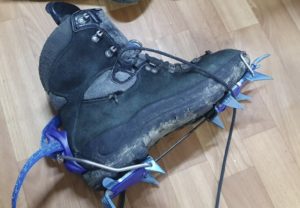An Unexpected Complication in Amur leopard population monitoring this winter by Petr Mametiev, WCS Russia

Amur leopard monitoring © WCS Russia
In mid-January 2021, we arrived at Land of the Leopard National Park to begin setting out camera traps for the 2021 Amur leopard population monitoring season, a project that has been ongoing since 2002. We consider ourselves quite experienced at this point as a result: we’ve seen it all, and know each curve of the landscape in our 1,000 square kilometer study area. We pass river bends and are reminded of a sounder of wild boar we once surprised there, splashing in the water and squealing in escape, and pause on a ridge to recall a flock of migrating geese that once passed so low over our heads that we could hear their gasps of exhaustion as they pushed south through the sky. Little did we know, however, how unique the 2021 field season would be.
In November 2020, an early winter ice storm descended on southwest Primorye, followed by a deep and prolonged freeze. Even by January the hills remained encased in a solid, thick layer of ice and subsequent snowfalls dusted this surface with a shallow covering of snow. This made it practically impossible to ascend the steep slopes to reach the ridges where we set our traps. A typically-quick ascent of 10-15 minutes turned into 45-90 minutes of teeth-clenching struggle; pulling ourselves upslope from one handhold to the next. After successfully placing our first few traps we realized that these were in the flattest areas, and it dawned on us that the steepest and most remote sites were still ahead for our Amur leopard monitoring. This was unsustainable and dangerous.

Ice crampons © WCS Russia
We abandoned our work to drive into the city of Vladivostok some three hours away, where we went from store to store looking for ice crampons. This is a city unaccustomed to such needs, and any that stores may have once had were now long sold out. We found some recreational ice cleats—the kind of thing people use for extra grip on icy sidewalks—but these were useless for our needs. Two pairs shredded on their first day in the forest. We needed mountaineering-grade equipment, and the closest place we could find such gear in Russia was in Moscow, some 6,400 kilometers to our west. We ordered four pairs of ice crampons and two ice axes—items we never thought we’d need in Primorye.
Outfitted as though to storm a glacier, we returned to the field and succeeded in placing all of our cameras in the forest.

